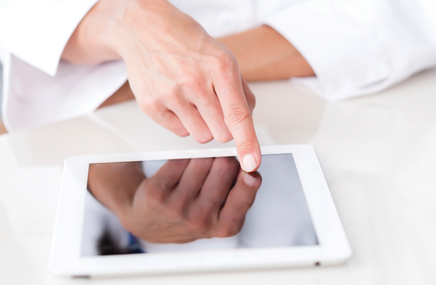It’s highly doubtful whether even the visionary who came up with the idea for iPad in the first place could have foreseen the magnitude of its impact on physicians, and also on the industry that likes to call on them as often as possible.
It’s a well-documented fact: Physicians just love their iPads. An estimated two-thirds of docs own a tablet device and, according to MD Mindset, 54% use them in their practices.
The HCP community has, to date, remained fiercely loyal to Apple but it remains to be seen whether allegiances will be tested as more options become available and at lower price points in the market.
Of course, if doctors love iPads, then it follows that pharmaceutical sales reps love them too (okay, maybe not the true love displayed by the docs.) For an industry not traditionally known for its nimbleness and agility, pharma sure was quick to identify the iPad as the almost-perfect detailing machine, to recognize the potential of physicians’ built-in affinity with the device, and to deploy it en masse in the field. In many cases, the iPad has become something of a golden ticket for accessing and reaching physicians. And the ROI is tangible.
We’ll come back to that in a moment. For now, let’s take a look at some of the trends and behavioral data in the online physician community.
The first thing to know is that a lot of online activity takes place in the doctor’s office—and across multiple screens, too. The Manhattan Research/Google Physician Channel Adoption Study in June 2012 showed that 99% of physicians use a desktop/laptop in the office, with 87% using a smartphone or a tablet device in the workplace. Clearly, there’s a lot of screen-hopping going on.
Other notable findings include the fact that when physicians are making clinical decisions, they tend to spend twice as much time using online resources compared to print. Digital adoption is not just the domain of the younger doctors, either. Among physicians aged 55 and over, 80% own a smartphone. They spend nine hours per week online for professional purposes, 84% use search engines daily and 64% of their online time is spent using resources for clinical decisions.
Search is still the number one activity among HCPs: 98% use their desktop/laptop to search, 56% use their mobile, while 63% use their tablet. The leading prompts for doing a search all relate to the patient: “When patient requested more info during consult” (68%), “After patient requested specific drug” (62%) and “After patient reported drug side effect” (61%).
Interestingly, the next four most popular reasons grouped together all the “independent research” reasons. The least popular search reasons were all relating to promotional efforts, such as follow-up on a rep visit or follow-up on an ad. But before you start reallocating your paid-search dollars, bear in mind that these prompts still scored reasonably high with around a third of HCPs reporting that each has promoted them to search.
Looking now at physicians’ smartphone use, again, search is the most popular activity, using up 48% of their phone time, with professional apps using an additional 38%. Unsurprisingly, docs have little patience with non-optimized sites, with 62% saying they would be likely to leave such a site. Unfortunately, 41% said they are led to mobile-optimized sites “only occasionally.” There’s an obvious take away here, so make sure you get on that.
Physicians watch a decent amount of online video—six hours per week on average, with around half of that for professional purposes. This almost matches their weekly TV viewing average of eight hours. They watch online videos across all three screens, too: desktop/laptop (67%), smartphone (13%) and tablet (29%). And when it comes to video content, the leading category is CME (55%). Interestingly, 29% expressed an interest in watching videos to show to their patients.
Okay, back to the drug reps storyline. Last year, Manhattan Research’s annual physician offered an early glimpse of the ROI potential of iPads. 29% of ePharma Physicians said they’d be more likely to consider prescribing a drug—and 35% would be more likely to request a sample—if the rep had used an iPad in the call.
And an MD Mindset survey showed sales calls incorporating an iPad score 8%-12% higher on key performance indicators than did non-tablet calls. What’s more, calls using iPads resulted in a 90% reduction in the proportion of short visits (of two minutes or less).
However, the same study reported that sales reps who possess an iPad used them in just 30% of their calls. Are they mad?
Dialing in to docs
87% of physicians use a smartphone or a tablet in their practice‡
2:1 is the ratio of time physicians spend using online resources vs. print when making clinical decisions‡
62% of physicians are likely to abandon a mobile website if it’s not optimized for the device‡
70% of the sales calls made by reps who possess an iPad do not incorporate the device**
8-12% increase in key performance indicators when an iPad is used in a call**
90% reduction in the proportion of short calls (of less than 2 minutes) when an iPad is used**
Sources: ‡ Manhattan Research-Google Physician Channel Adoption Study
** MD Mindset: Use of iPads by Pharmaceutical Sales Professionals, July 2012
From the February 01, 2013 Issue of MM+M - Medical Marketing and Media








